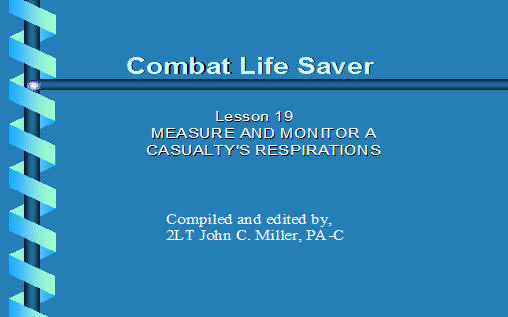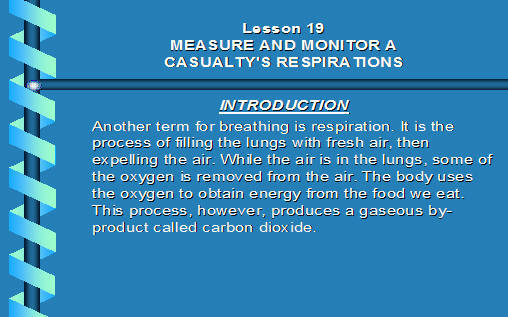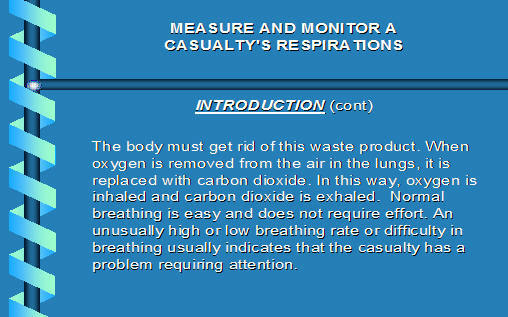MEASURE AND MONITOR A CASUALTY'S RESPIRATIONS
Click here to download the presentation.



Lesson 19
MEASURE AND MONITOR A
CASUALTY’S RESPIRATIONS
INTRODUCTION
Another term for breathing is respiration. It is the process of filling the lungs with fresh air, then expelling the air. While the air is in the lungs, some of the oxygen is removed from the air. The body uses the oxygen to obtain energy from the food we eat. This process, however, produces a gaseous by-product called carbon dioxide.
MEASURE AND MONITOR A
CASUALTY’S RESPIRATIONS
INTRODUCTION (cont)
The body must get rid of this waste product. When oxygen is removed from the air in the lungs, it is replaced with carbon dioxide. In this way, oxygen is inhaled and carbon dioxide is exhaled. Normal breathing is easy and does not require effort. An unusually high or low breathing rate or difficulty in breathing usually indicates that the casualty has a problem requiring attention.
MEASURE AND MONITOR A
CASUALTY’S RESPIRATIONS
TASK
Determine a casualty’s respiration rate and describe characteristics of the respirations.
CONDITIONS
Given a simulated casualty and a timepiece with a second hand.
STANDARDS
Score a GO on the performance checklist.
COUNT THE CASUALTY’S RESPIRATIONS
You must carefully observe the casualty’s chest for one full minute in order to determine his respiration rate. One respiration consists of one inhalation where the chest rises and one exhalation where the chest falls. You will get a more reliable count if the casualty is not aware that you are counting his respirations. If his attention is focused on his own breathing, he may change the rate, depth, and rhythm of his respirations. If you are monitoring a casualty, observe his respirations immediately after you check his pulse without letting the casualty know that you are through taking his pulse and are actually observing the rise and fall of his chest.
COUNT THE CASUALTY’S RESPIRATIONS
Have the casualty lie on his back.
Take the casualty’s radial pulse for one full minute.
Without changing position, begin counting his respirations out loud.
Begin the time when the casualty begins to inhale. Do not count the respiration until the casualty has exhaled.
Count the casualty’s respirations for one full minute.
COUNT THE CASUALTY’S RESPIRATIONS
Question:
I started timing the respirations when the casualty began to inhale. I counted the respirations when he completed the exhalation. Suppose he was just completing an inhalation when the 60 seconds ended. Would I count the inhalation as a respiration?
Response:
No. The casualty must complete both an inhalation and an exhalation before it is counted.
LOOK FOR CHARACTERISTICS OF NORMAL
AND ABNORMAL RESPIRATION
The normal range of respiration rates in an adult when resting is 12 to 20 respirations per minute.
A breathing rate that is slower than 12 respirations per minute or faster than 20 respirations per minute may indicate a problem affecting the casualty’s ability to get and absorb oxygen.
A respiration rate below 12 respirations per minute is called slow.
A respiration rate above 20 respirations per minute is called rapid.
LOOK FOR CHARACTERISTICS OF NORMAL
AND ABNORMAL RESPIRATION
Normal respiration are deep and even. The rib cage expands fully. Contraction and relaxation of the diaphragm can be detected by observing the casualty’s abdomen.
In shallow breathing, the chest and abdomen move very little.
A pattern of shallow, slow respirations is called hypoventilation.
A pattern of rapid, deep respirations is called hyperventilation.
LOOK FOR CHARACTERISTICS OF NORMAL
AND ABNORMAL RESPIRATION
If the respirations are shallow and rapid, the casualty is said to be short of breath. Irregular breathing rhythm, labored breathing, and noises (such as wheezing) produced during breathing may indicate the presence of injury or illness.
Question:
What medical term is used to describe difficulty in breathing?
Response:
Dyspnea.
MONITOR THE CASUALTY’S RESPIRATIONS
If you remain with the casualty, you must monitor his breathing. If his breathing stops and you are not in a chemical environment, you must administer mouth-to-mouth or mouth-to-nose resuscitation. Even if his breathing does not stop, changes in respiration rate, depth, and regularity may indicate that his condition is improving or becomes worse. Report abnormalities and changes to medical personnel.
MEASURE AND MONITOR A
CASUALTY’S RESPIRATIONS
CLOSING
Normal breathing should be effortless and even in rhythm, and should not produce noise or discomfort. Any change from normal breathing can be a warning sign that the casualty is in trouble.
Questions